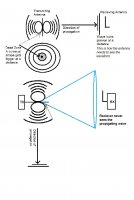Shaun Stanton
Member
T. Rexxer,
I just got the ground station and FVP setup together so I have only made a few test runs. I have been probably 500' out from it. I have a weird interferance that cuts in and out that I'm trying to fix. Not sure yet if it is just a weak transmitter or vibration or some such. No goggles yet but I plan on getting a set at some point (the TV was a cheap quick solution).
Thanks for looking!
One thing that will affect the video signal is the orientation of the antenna based off the altitude and distance of your copter to your receiver. All radio waves have a hole known as a dead zone or cone of silence that is parallel to the cylindrical dipole antenna. This hole gets larger as the TX gets farther away from the RX. If your copter is at a shallow altitude but at a far enough distance and your TX antenna is horizontal, pointed directly at the RX then you enter this dead zone and will get loss of signal. As you bring the copter closer to you then the signal will return. If you rotate the copter i.e yaw it then you will be out of that zone, that could be why the video cuts in and out. If you fly far distances that make the copters angle to you shallow, you will want your TX and Rx antennas to be vertical so no matter how you yaw it the antenna will see the radio wave. The exact opposite is true if you are flying high and the copter is close to you, because you will want the antenna to be Horizontal. Here is an example of what this is doing.
View attachment 11460
So you have to keep in mind where the antenna is going to be oriented in relation to the ground station in order to keep out of the dead zones. The receiver antenna needs to be oriented correctly as well in order to achieve the best oscillatory response with the electron flow inside the antenna itself. They way dipole receiving antennas work is electrons oscillating up and down the cylinder from sensing the radio wave.
There are pros and cons to different types of frequencies. Higher frequencies have more bandwidth and higher fidelity for transmission bandwidth. They have smaller dead zone cones. However, higher frequencies have shorter wavelengths dissipate faster and are more susceptible to attenuation. This is due to the conservation of energy principle. The converse is true with respect to lower frequencies such as 900 MHz. 900 Mhz will travel longer distances and attenuate less than 5.8 however the cone is wider than 5.8 so these will be more susceptible to getting in the cone of silence. People like 1.2/1.3 systems because it is one that seems to be the somewhere in the middle for most situations. Then you will have longer wave that will not attenuate as much from obstacles such as trees, cars and buildings. 1.2 Ghz seems is far enough away from the 2.4 Spectrum that they should not get interference with your RC radio.

